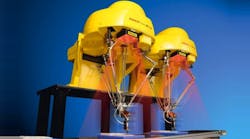If Rethink Robotics' Baxter is the face of the new generation of robots, then the mascot for the old generation must be FANUC's bold yellow robotic arms.
Towering over car assemblies and heavy-duty parts facilities for decades, these robots stand almost as the antithesis to the new human-friendly designs: hardware-based, massive, dangerous and capable of superhuman feats of power and precision.
However, just like those new automation masters at Rethink Robotics and its Danish rival Universal Robots, Mike Cicco, general manager of distribution sales at FANUC America (IW 1000/648), envisions a future in which robots and humans can one day work side-by-side in harmony.
"As robots get smaller and get closer to doing the things that people can do," he said, "I see robots and people getting closer in proximity as well."
As that goes, just like the collaborative champions, he sees the walls and cages that have kept man and machine apart all these years inevitably giving way, creating a new industrial future that includes a setting in which, "a mix of robots and humans can work together to do manufacturing," he said.
And just like Rethink and Universal, FANUC has robots on the market trying to make that future happen.
In FANUC's case, it is the M-1iA and M-3iA Delta units, which are, like those of the collaborative variety, cheap enough and smart enough and simple enough to help automate systems even in the traditionally underserved small and medium sized shops.
But that's where the similarities end.
The slow-moving, low-power mechanics that make Baxter and it's like safe for human collaboration represent a shift in robotics that FANUC can't yet get behind.
"Whenever we go up to a customer – no matter if it's a big, small or medium sized company – we ask them, 'Do you want your robots to move slower?'" Cicco recalled. "The answer is always no. Nobody wants their robots to go slower."
The only reason customers buy robots, he said, is "because they want them to go super fast." Opting for one of those "painfully slow" collaborative units, as he described them, defeats the point.
The Superhuman Heart of Robots
"Robots are meant to be fast and precise; that's what we do," Cicco explained. "From our position, a smaller robot just means you can get even faster and more precise."
And that, he said, is where his company diverges from the newcomers.
"There's a big difference between a collaborative robot, which is what Rethink and Universal make, and collaborating with robots," he explained.
To comply with RIA safety regulations – which are still a little hazy – collaborative robots are designed to be force and torque limiting. That way, if a worker is hit by an errant arm or steps in the way of production, the impact is minimal, or at least on par with running into a human doing the same task.
To accomplish that, Cicco said, those robots have to use small motors and small gear reductions to limit their power. And that, while helping promote safety, may also shorter their life the field while limiting potential gains in speed and precision.
FANUC, however, has taken another approach.
"With the Delta, we went the other way – we use our really fast, normal-sized motors even in the smallest robots and then use software to allow them to go slow and interact with people when it needs to and then go fast and precise when it is on its own."
This is a divergent move, and one that lands the company smack in the middle of the two generations.
By equipping robots with state of the art sensors and sensing software, FANUC is creating a half-generation shift in robotics that allows interaction, even close work outside the safety cages, which helps define the new generation without giving up with superhuman capabilities that defined the old.
"Instead of having a collaborative robot, we have software that takes any of our robots – big ones and small ones – and makes it possible to collaborate with them," Cicco explained. "So even though our robots aren't force limiting, we still have the safety software there to slow down when it senses a person is there, stop when it gets too close. That way a person can interact with it."
This, he said, is where robotics is headed. Not to the simplified, humanoid workers of sci-fi, but to safer, smarter, high-speed versions of the industrial tools already at work.
"That's the way I see it going in the future," he said. "We're going to see more interaction between humans and all types of robots. They're both going to be working on the same thing at the same time in the same place, but doing their own individual tasks."




